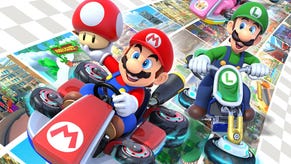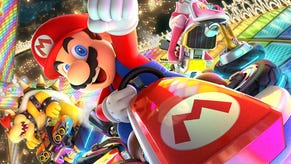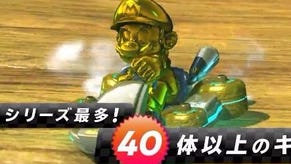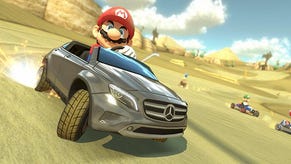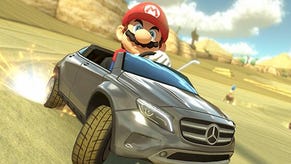Mario Kart 8 DLC Pack One review
Kart before the horse.
How wonderful it is to have F-Zero back. There's plenty of fan service in the first DLC pack for Mario Kart 8, but none of it hits quite as hard as the once-forgotten series' slight return, its anti-grav track winding blissfully through Nintendo's hyper-clean vision of the future. The newly introduced race through Hyrule Castle might hit some high notes, sure, but we get to walk between these parapets every other year. The steel-blue metropolis of Mute City has been lost to home consoles for well over a decade.
The series lived on, of course, in Mario Kart 8's newfound passion for the vertiginous, and for the ludicrous twists and switchbacks that defined F-Zero 64 before they were cut brilliantly loose in F-Zero GX. That game's director, Toshihiro Nagoshi, once likened the design of its tracks to writing a song (something he perhaps picked up from his mentor Yu Suzuki, who designed the breezy sweep of OutRun's jaunt with the soundtrack always in mind) - and so GX's courses were full of dazzling solo stretches that hammered the player with searing twists before building up to climaxes of impossible speed.
Mario Kart 8's Mute City isn't quite the measure of the likes of GX's Intersection or Ordeal, but it's a neat deepening of the link between Nintendo's flagship series and one of its fading stars. Mute City contains explicit nods to F-Zero - boost pads are replaced by that distinctive yellow chevron, and coins are usurped by energy strips around the course - as well as that crunchy guitar theme, enlivened in Mario Kart 8 style by hyperactive brass punches.
Nintendo understands the music of course design, and it's found elsewhere in the eight tracks introduced by the DLC pack. Dragon Driftway, a course that sends you down the spine of Super Mario Galaxy 2's Gobblegut, snakes and spirals with such delirious abandon it deserves a place amidst GX's own power ballads - and it's quite enough to send the room spinning once you've finished traversing three disorientating laps. Ice Ice Outpost, another all-new creation for Mario Kart 8's DLC, also has something of a futuristic edge, its starker aesthetic suited more to Wipeout than Nintendo's cuddly series. The dynamics aren't quite as severe, but it's just as ingenious, two tracks intersecting each other and riddled with some of the game's trickier short-cuts.
Older tracks sing a similarly sweet music. The original Rainbow Road makes its fourth outing in the series, its twist coming from the ripples the Star Thwomps send along the glistening surface that can be trick-boosted from, while Yoshi Circuit returns once again, the switchback scales at the back of the circuit still providing one of Mario Kart's sternest challenges. Wario's Gold Mines plucked from Mario Kart Wii, gets a minor facelift, its half-pipe stripped out while the carts that meander across its rickety rails now afford a speed boost upon collision. Its stomach-churning swoops and breakneck ascents ensure it nestles in comfortably amidst Mario Kart 8's existing line-up.
The new DLC marks a turning point for Mario Kart, though, where it opens up its horizons beyond the Mushroom Kingdom. At first glance there's something slightly incongruous about it. The sight of Peach in a cat-suit, piloting the slippery Blue Falcon past the chomping Deku Babas on the outskirts of Hyrule Castle feels like fan fiction that's gone too far, though Mario Kart gels it all together - just - through its judicious use of detail.
It's that detail that made Mario Kart 8 sing earlier this year - from small animations like the Luigi death stare that became a viral phenomenon to subtler, more meaningful changes like the introduction of new boost mechanics that always kept the player engaged. It's that detail, too, that meant while others were preoccupied with the new generation arms race, Nintendo quietly produced the best-looking console game of the year. That detail is all present and correct in the new tracks and riders, making for some great little flourishes.
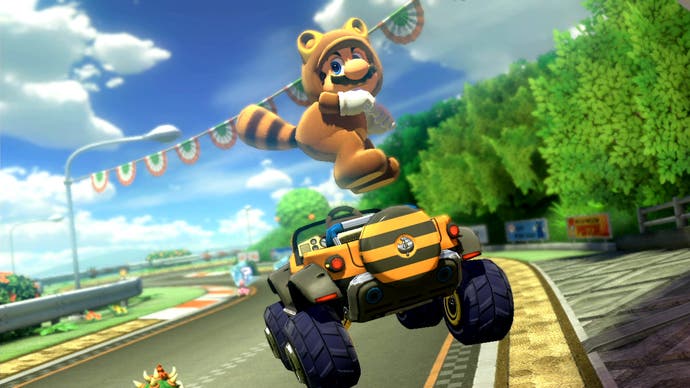
Like how Tanooki Mario turns to stone when performing his stunt boost, momentarily frozen in mid-air, or how rupees replace coins throughout the Hyrule Castle circuit. Or how the shortcut in the midst of the Legend of Zelda track can only be unlocked by hitting three crystal switches, resulting in that familiar triumphant fanfare. It's that detail that helps smooth the wider world of Nintendo into Mario Kart, too - Link fits in as well as he can riding his Epona bike, but there's something heart-arrestingly adorable about the sight of him on a kart, his gangly legs sticking out either side of the steering wheel. Only Nintendo, too, could fit a spine of procedural generation into one of its courses with such deft grace, the bounds of the Excitebike track subtly shifting each time you return to the track.
This first bundle of DLC does a fantastic job of leaning on Nintendo's past, so it's just a slight shame that it hasn't learnt from one of Mario Kart 8's only failings and taken the opportunity to overhaul the somewhat limp Battle mode - which, in this instance, hasn't been touched at all. It's a small shame, too, that now Nintendo's folded all of its franchises together, the odds of a standalone F-Zero seem slimmer than ever. Still, it's hard to complain when the future of Mario Kart has been expanded so graciously, and now that one of 2014's best games has just been made that little bit better.





